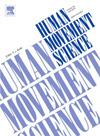运动疲劳对举重运动中神经肌肉控制策略的影响:基于小波包变换的肌肉协同研究
IF 1.9
3区 心理学
Q4 NEUROSCIENCES
引用次数: 0
摘要
重复性举重引起的腰痛是工人的一个重要健康问题,疲劳通常被认为是一个关键的风险因素。然而,目前缺乏关于运动引起的疲劳对神经肌肉控制模式的影响的研究,这可以通过基于肌表电图(sEMG)信号的肌肉协同作用来识别。本研究采用小波包变换(WPT)结合非负矩阵分解(NNMF)从肌肉协同的角度研究举重任务,探讨运动性疲劳下肌肉协同模式的特征。11名参与者被招募来执行重复的举重任务,直到主观疲劳。利用NNMF方法,确定了与起重任务相关的三个模块。值得注意的是,主要涉及TA和LES的模块表现出更高的激活水平,表明该模块需要更多的神经资源调节。然而,在NNMF方法中没有发现疲劳对肌肉协同作用的影响。此外,WPT-NNMF方法显示疲劳对不同频段和协同模块的影响不一致。总的来说,随着频带的增加,运动疲劳对肌肉协同作用的影响增强,以TA和LES为特征的模块的影响比其他两个模块更为明显。本文章由计算机程序翻译,如有差异,请以英文原文为准。
The influence of exercise-induced fatigue on neuromuscular control strategies during lifting tasks: A muscle synergy study based on wavelet packet transform
Repetitive lifting-related low back pain is a significant health issue among workers, in which fatigue is generally identified as a critical risk factor. However, there is currently a lack of research on the effects of exercised induced fatigue on neuromuscular control patterns, which can be identified through muscle synergy based on the signals of surface electromyographic (sEMG). This study employs a wavelet packet transform (WPT) combined with non-negative matrix factorization (NNMF) to investigate the lifting task from the perspective of muscle synergy and to explore the characteristics of muscle synergy patterns under exercise-induced fatigue. Eleven participants were recruited to perform a repetitive lifting task until subjective fatigue. Utilizing the NNMF method, three modules associated with the lifting task were identified. Notably, the module primarily involving the TA and LES exhibited a higher activation level, indicating that this module requires greater neural resource regulation. However, the effect of fatigue on muscle synergy was not found in NNMF method. Additionally, the WPT-NNMF method revealed that the effects of fatigue on different frequency bands and synergy modules were inconsistent. Overall, as the frequency band increased, the impact of exercise-induced fatigue on muscle synergy intensified, with a more pronounced effect observed in the module characterized by TA and LES compared to the other two modules.
求助全文
通过发布文献求助,成功后即可免费获取论文全文。
去求助
来源期刊

Human Movement Science
医学-神经科学
CiteScore
3.80
自引率
4.80%
发文量
89
审稿时长
42 days
期刊介绍:
Human Movement Science provides a medium for publishing disciplinary and multidisciplinary studies on human movement. It brings together psychological, biomechanical and neurophysiological research on the control, organization and learning of human movement, including the perceptual support of movement. The overarching goal of the journal is to publish articles that help advance theoretical understanding of the control and organization of human movement, as well as changes therein as a function of development, learning and rehabilitation. The nature of the research reported may vary from fundamental theoretical or empirical studies to more applied studies in the fields of, for example, sport, dance and rehabilitation with the proviso that all studies have a distinct theoretical bearing. Also, reviews and meta-studies advancing the understanding of human movement are welcome.
These aims and scope imply that purely descriptive studies are not acceptable, while methodological articles are only acceptable if the methodology in question opens up new vistas in understanding the control and organization of human movement. The same holds for articles on exercise physiology, which in general are not supported, unless they speak to the control and organization of human movement. In general, it is required that the theoretical message of articles published in Human Movement Science is, to a certain extent, innovative and not dismissible as just "more of the same."
 求助内容:
求助内容: 应助结果提醒方式:
应助结果提醒方式:


